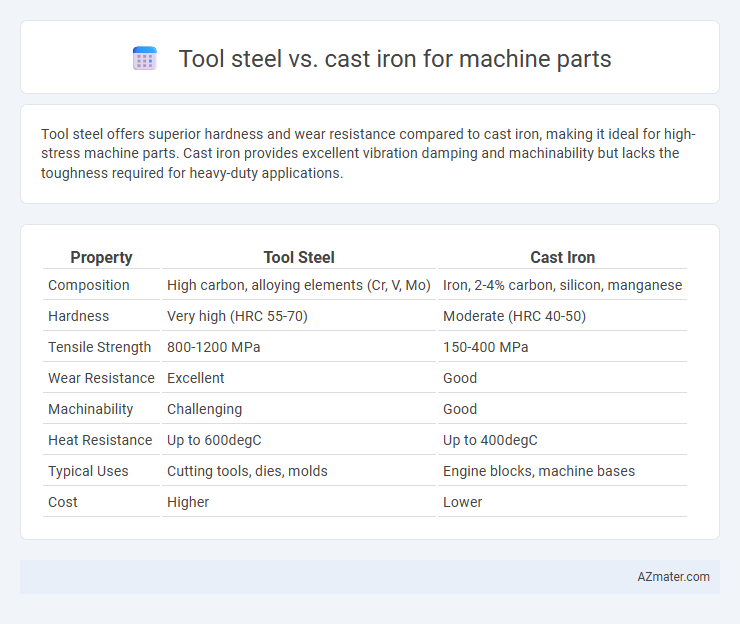Tool steel offers superior hardness and wear resistance compared to cast iron, making it ideal for high-stress machine parts. Cast iron provides excellent vibration damping and machinability but lacks the toughness required for heavy-duty applications.
Table of Comparison
| Property | Tool Steel | Cast Iron |
|---|---|---|
| Composition | High carbon, alloying elements (Cr, V, Mo) | Iron, 2-4% carbon, silicon, manganese |
| Hardness | Very high (HRC 55-70) | Moderate (HRC 40-50) |
| Tensile Strength | 800-1200 MPa | 150-400 MPa |
| Wear Resistance | Excellent | Good |
| Machinability | Challenging | Good |
| Heat Resistance | Up to 600degC | Up to 400degC |
| Typical Uses | Cutting tools, dies, molds | Engine blocks, machine bases |
| Cost | Higher | Lower |
Introduction to Tool Steel and Cast Iron in Machine Parts
Tool steel is favored in machine parts for its exceptional hardness, wear resistance, and ability to retain a sharp edge under high-stress conditions, making it ideal for cutting tools and dies. Cast iron, known for its excellent castability, high compressive strength, and good vibration damping properties, is commonly used in machine bases and frames. The choice between tool steel and cast iron depends on specific application requirements, including strength, durability, and manufacturing processes.
Material Composition and Properties
Tool steel, primarily composed of iron with added carbon (usually 0.5-1.5%) and alloying elements like chromium, vanadium, and molybdenum, offers exceptional hardness, wear resistance, and toughness, ideal for high-stress machine parts. Cast iron, containing 2-4% carbon and significant silicon, provides excellent compressive strength and vibration damping but lacks the tensile strength and toughness of tool steel. The distinct material compositions result in tool steel being preferable for precision components requiring durability, whereas cast iron suits heavy-duty structures where wear resistance and castability are critical.
Manufacturing Processes and Machinability
Tool steel offers superior machinability and precision during manufacturing processes, including forging, milling, and grinding, due to its controlled alloy composition and heat treatment capabilities. Cast iron, while easier to cast into complex shapes through foundry methods, presents machining challenges like tool wear and surface finish issues due to its abrasive graphite flakes and higher brittleness. Selecting tool steel is ideal for high-precision machine parts requiring durability and tight tolerances, whereas cast iron suits applications where cost-effective casting and vibration damping are prioritized.
Hardness and Wear Resistance Comparison
Tool steel exhibits significantly higher hardness compared to cast iron, typically ranging from 55 to 65 HRC, which enhances its ability to withstand heavy mechanical stress. This increased hardness directly contributes to superior wear resistance, making tool steel the preferred choice for machine parts subjected to repetitive friction and abrasive conditions. Cast iron, while offering good compressive strength and damping capacity, usually falls between 40 and 50 HRC and tends to wear faster under high-stress scenarios.
Strength and Toughness Differences
Tool steel offers superior strength and toughness compared to cast iron, making it ideal for high-stress machine parts that require resistance to wear and impact. Cast iron, while having good compressive strength and excellent damping properties, is more brittle and prone to cracking under tension or shock loads. The enhanced toughness of tool steel enables it to absorb sudden forces without fracturing, whereas cast iron's brittleness limits its use in applications demanding high impact resistance.
Corrosion and Heat Resistance
Tool steel exhibits superior heat resistance compared to cast iron, maintaining mechanical properties at elevated temperatures due to its alloy composition with elements like chromium and vanadium. Cast iron tends to have lower corrosion resistance, as its porous microstructure allows moisture penetration, whereas tool steel's denser structure and alloying elements form a protective oxide layer that enhances durability against rust. For machine parts exposed to high temperatures and corrosive environments, tool steel offers enhanced longevity and performance over cast iron.
Cost and Availability Considerations
Tool steel generally provides superior strength and wear resistance for machine parts but comes at a higher cost compared to cast iron, which is more affordable and widely available. Cast iron offers excellent machinability and vibration damping but lacks the toughness and impact resistance of tool steel, making it suitable for less demanding applications. The availability of cast iron in diverse grades and its lower production costs make it a cost-effective choice for large-scale manufacturing.
Common Applications in Machinery
Tool steel is widely used in machinery for cutting tools, dies, and molds due to its high hardness, wear resistance, and ability to withstand high temperatures, making it ideal for precision applications. Cast iron is common in machine parts such as engine blocks, machine bases, and housings because of its excellent vibration damping, good machinability, and cost-effectiveness. Both materials serve distinct roles in machinery, with tool steel excelling in durability and performance under stress, while cast iron provides stability and strength for heavy-duty structural components.
Maintenance and Service Life
Tool steel offers superior maintenance advantages and extended service life compared to cast iron due to its higher hardness, wear resistance, and toughness. Cast iron, while cost-effective and easy to machine, tends to experience faster wear and potential cracking under heavy stress, increasing maintenance frequency. Selecting tool steel components enhances durability and reduces downtime in demanding machine part applications.
Choosing the Right Material for Machine Parts
Selecting tool steel over cast iron for machine parts hinges on performance requirements such as hardness, wear resistance, and toughness. Tool steel offers superior strength and durability, making it ideal for high-stress components subjected to repeated impact and abrasion. Cast iron provides excellent compressive strength and vibration damping but is more brittle, limiting its use in applications where toughness and machining precision are critical.

Infographic: Tool steel vs Cast iron for Machine part
 azmater.com
azmater.com